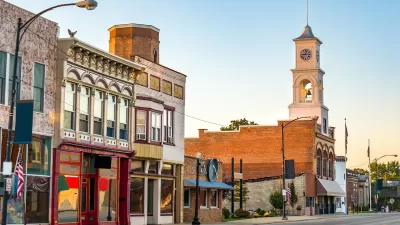I recently had the pleasure of sitting on a panel convened by the Lincoln Instititute of Land Policy to discuss the Tea Party and its effects on local planning (a topic I've discussed earlier on this blog). At one point, the moderator asked if there were any successful techniques that planners could use to effectively deal with Tea Party activists. This was an intriguing question, but also one that I thought was a bit odd. Controversy and conflict are not new to planning; they are built into the very process of American planning because of its inherent openness and inclusiveness.
I recently had the pleasure of sitting on a panel convened by the Lincoln Instititute of Land Policy to discuss the Tea Party and its effects on local planning (a topic I've discussed earlier on this blog). At one point, the moderator asked if there were any successful techniques that planners could use to effectively deal with Tea Party activists. This was an intriguing question, but also one that I thought was a bit odd. Controversy and conflict are not new to planning; they are built into the very process of American planning because of its inherent openness and inclusiveness. The development approval process is inherently political, and planners are required to address a wide range of issues from participants, sometimes informed, often times not, during the process. Conflict and tension are inevitable, and often planners are the ones that are responsible for resolving them. In fact, I believe professional planners are often the best equiped to deal with these public controversies.
So, the question really is: Are Tea Party activists that much different from others participating in the public approval process? Is a Tea Partier different in a fundamental way from a NIMBY? Or a bicycle activist opposing a new road? Or a road warrior opposing a bicycle lane? I think not, and I think planners too often give too much credence to the Tea Party as an independent political force on the local level. In reality, Tea Party activists are ordinary citizens, and the vast majority were activized by national policy issues, not local (or regional) planning. Some are informed. Some are not. Some have real concerns, others simply don't understand the process or the project at hand. Planners serve a crucial role in bringing different sides to the table to help identify common ground (or sometimes more importantly areas of irreconcileable differences), in order to move public decisionmaking forward.
Accomplishing this task is not easy. As Tea Party activists become more involved on the local level, understanding their concerns and motivations will be crucial for identifying productive paths forward.
Interestingly, I have just completed teaching a course for pofessional masters students at Florida State University that grapples with controversial issues, very much modeled on the practical problems of resolving local conflicts in local planning. Each week, the course highlighted an issue such as neigbhorhood development, land-use regulation and housing affordablity, transit-oriented development or urban slums, required students to read peer-reviewed research on both sides (often crossing academic disciplines), and then debate the pros and cons of a proposed project. The crucial role was played by the facilitator--the professional planner--whose job was to forge a path forward that addressed the concerns of both sides. Importantly, in each case, a path forward based on consensus was identified even though some students were always required to take hardline positions. (As a planning board member and chair, I faced similar types of problems on everything from rezonings that would potentially add hundreds of housing units to small parcel stormwater drainage, the bread and butter issues of local planning.)
We discovered, not unlike my exeperience running planning board meetings, that a mutually beneficial path forward is often possible even with people representing widely divergent views. Understanding and listening to all sides, giving each the respect that the public process demands, is a key part of achieving this goal. The solution is also in discerning which are real issues and which are largely rhetorical but carry a deeper meaning. Someone arguing against "Agenda 21" is often really motivated by a perceived fear that control over their community is being abdicated to non-local authorities. Citizens criticizing charettes and other planning excercises are often really concerned that they are being shut out of the decisionmaking process, or the process is unresponsive to ordinary citizen concerns.
For planners really interested in understanding the Tea Party, I suggest reading a few important books that really attempt to lay out their issues in their own words to understand their world view. Among the ones I have felt were most useful include,
- Scott Rasmussen and Doug Schoen, Mad as Hell: How the Tea Party is Remaking the Two Party System;
- Mark Meckler and Jenny Beth Martin, Tea Party Patriots and the Second American Revolution;
- Kate Zernike, Boiling Mad: Inside Tea Party America.

Maui's Vacation Rental Debate Turns Ugly
Verbal attacks, misinformation campaigns and fistfights plague a high-stakes debate to convert thousands of vacation rentals into long-term housing.

Planetizen Federal Action Tracker
A weekly monitor of how Trump’s orders and actions are impacting planners and planning in America.

Chicago’s Ghost Rails
Just beneath the surface of the modern city lie the remnants of its expansive early 20th-century streetcar system.

Bend, Oregon Zoning Reforms Prioritize Small-Scale Housing
The city altered its zoning code to allow multi-family housing and eliminated parking mandates citywide.

Amtrak Cutting Jobs, Funding to High-Speed Rail
The agency plans to cut 10 percent of its workforce and has confirmed it will not fund new high-speed rail projects.

LA Denies Basic Services to Unhoused Residents
The city has repeatedly failed to respond to requests for trash pickup at encampment sites, and eliminated a program that provided mobile showers and toilets.
Urban Design for Planners 1: Software Tools
This six-course series explores essential urban design concepts using open source software and equips planners with the tools they need to participate fully in the urban design process.
Planning for Universal Design
Learn the tools for implementing Universal Design in planning regulations.
planning NEXT
Appalachian Highlands Housing Partners
Mpact (founded as Rail~Volution)
City of Camden Redevelopment Agency
City of Astoria
City of Portland
City of Laramie






























